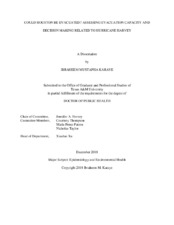| dc.description.abstract | Background: Hurricane Harvey made landfall as a Category 4 storm on the Texas Gulf Coast on August 26, 2017. In this study, we assessed the feasibility of evacuating the Houston-Galveston region of the U.S. Gulf Coast.
Methods: First, we explored the spatial distribution of evacuation shelters in the Houston-Galveston MSA and estimated the shelter deficits in the region. Second, we conducted a statistical meta-analysis of 36 studies and identified the factors associated with hurricane evacuation decisions. Finally, we used an SF-12 instrument to assess the self-rated mental and physical health of residents in the Texas Gulf-Coast after hurricane Harvey. We also identified the factors associated with variations in self-rated health among the population.
Results: There was a disproportionate distribution of evacuation shelters in the Houston-Galveston MSA with high-capacity shelters clustered farther away (more than 120 miles) from the Coastal Zip-Zone, and low-capacity shelters clustered nearer (less than 50 miles) the Coastal Zip-Zone. In addition, the MSA had a prevailing aggregate shelter deficit for 353,713 persons. The factors significantly associated with hurricane evacuation were mobile home residence (r= 0.31; 95% CI: 0.21, 0.41), perception of risk (r= 0.18; 95% CI: 0.10, 0.26), Hispanic race (r= 0.08; 95% CI: 0.01, 0.14), and female gender (r= 0.05; 95% CI: 0.00, 0.09). Finally, the self-rated mental and physical health scores of residents in the Texas Gulf-Coast were 36.69 and 39.87 respectively, which were statistically significantly lower than national average.
Discussion: To improve the efficiency of evacuating the Houston-Galveston MSA in the face of hurricane, relevant authorities should make efforts towards eliminating prevailing shelter deficits. Second, information on factors associated with evacuation may enable the identification
of specific sub-population groups for evacuation interventions. Third, in the design of policy guidelines on disaster recovery, mental health services should be integrated with economic and educational empowerment programs and directed towards younger women with less than graduate level of education, who live in mobile homes with little children. Likewise, physical health rehabilitation programs after hurricanes should target evacuees at least 25 years of age who perceive medium to high risk of storm surge. | en |


